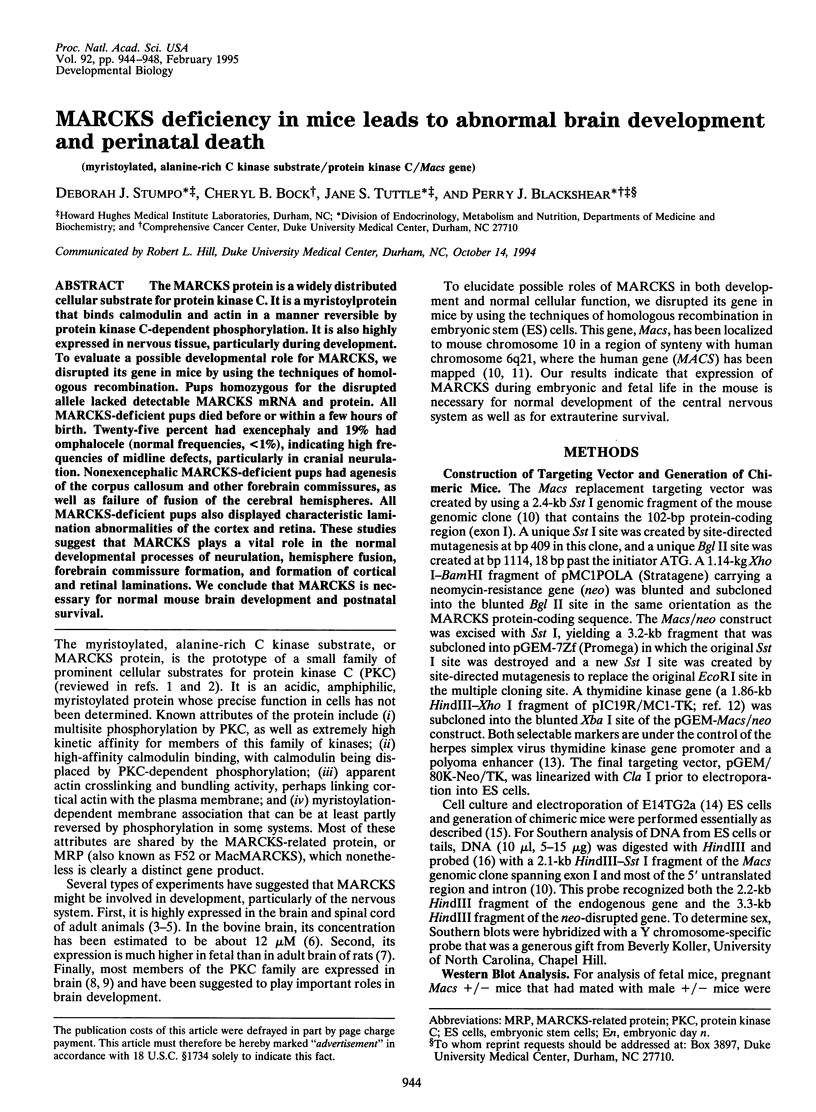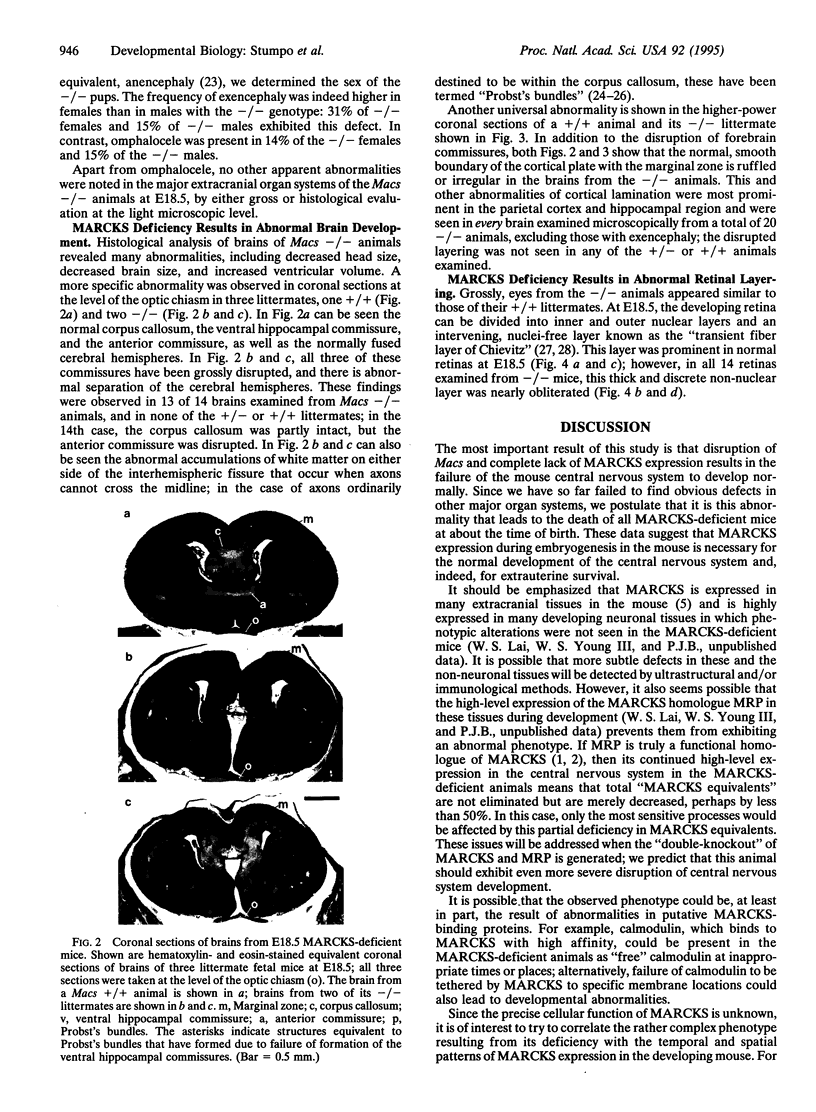Abstract
The MARCKS protein is a widely distributed cellular substrate for protein kinase C. It is a myristoylprotein that binds calmodulin and actin in a manner reversible by protein kinase C-dependent phosphorylation. It is also highly expressed in nervous tissue, particularly during development. To evaluate a possible developmental role for MARCKS, we disrupted its gene in mice by using the techniques of homologous recombination. Pups homozygous for the disrupted allele lacked detectable MARCKS mRNA and protein. All MARCKS-deficient pups died before or within a few hours of birth. Twenty-five percent had exencephaly and 19% had omphalocele (normal frequencies, < 1%), indicating high frequencies of midline defects, particularly in cranial neurulation. Nonexencephalic MARCKS-deficient pups had agenesis of the corpus callosum and other forebrain commissures, as well as failure of fusion of the cerebral hemispheres. All MARCKS-deficient pups also displayed characteristic lamination abnormalities of the cortex and retina. These studies suggest that MARCKS plays a vital role in the normal developmental processes of neurulation, hemisphere fusion, forebrain commissure formation, and formation of cortical and retinal laminations. We conclude that MARCKS is necessary for normal mouse brain development and postnatal survival.
Full text
PDF




Images in this article
Selected References
These references are in PubMed. This may not be the complete list of references from this article.
- Aderem A. The MARCKS brothers: a family of protein kinase C substrates. Cell. 1992 Nov 27;71(5):713–716. doi: 10.1016/0092-8674(92)90546-o. [DOI] [PubMed] [Google Scholar]
- Albert K. A., Nairn A. C., Greengard P. The 87-kDa protein, a major specific substrate for protein kinase C: purification from bovine brain and characterization. Proc Natl Acad Sci U S A. 1987 Oct;84(20):7046–7050. doi: 10.1073/pnas.84.20.7046. [DOI] [PMC free article] [PubMed] [Google Scholar]
- Albert K. A., Walaas S. I., Wang J. K., Greengard P. Widespread occurrence of "87 kDa," a major specific substrate for protein kinase C. Proc Natl Acad Sci U S A. 1986 May;83(9):2822–2826. doi: 10.1073/pnas.83.9.2822. [DOI] [PMC free article] [PubMed] [Google Scholar]
- Billette de Villemeur T., Chiron C., Robain O. Unlayered polymicrogyria and agenesis of the corpus callosum: a relevant association? Acta Neuropathol. 1992;83(3):265–270. doi: 10.1007/BF00296788. [DOI] [PubMed] [Google Scholar]
- Blackshear P. J. The MARCKS family of cellular protein kinase C substrates. J Biol Chem. 1993 Jan 25;268(3):1501–1504. [PubMed] [Google Scholar]
- Blackshear P. J., Tuttle J. S., Oakey R. J., Seldin M. F., Chery M., Philippe C., Stumpo D. J. Chromosomal mapping of the human (MACS) and mouse (Macs) genes encoding the MARCKS protein. Genomics. 1992 Sep;14(1):168–174. doi: 10.1016/s0888-7543(05)80300-3. [DOI] [PubMed] [Google Scholar]
- Blackshear P. J., Wen L., Glynn B. P., Witters L. A. Protein kinase C-stimulated phosphorylation in vitro of a Mr 80,000 protein phosphorylated in response to phorbol esters and growth factors in intact fibroblasts. Distinction from protein kinase C and prominence in brain. J Biol Chem. 1986 Jan 25;261(3):1459–1469. [PubMed] [Google Scholar]
- Caviness V. S., Jr Neocortical histogenesis in normal and reeler mice: a developmental study based upon [3H]thymidine autoradiography. Brain Res. 1982 Jul;256(3):293–302. doi: 10.1016/0165-3806(82)90141-9. [DOI] [PubMed] [Google Scholar]
- Caviness V. S., Jr, Rakic P. Mechanisms of cortical development: a view from mutations in mice. Annu Rev Neurosci. 1978;1:297–326. doi: 10.1146/annurev.ne.01.030178.001501. [DOI] [PubMed] [Google Scholar]
- Chery M., Formiga L. F., Mujica P., André M., Stehelin D., Dozier C., Gilgenkrantz S. Interstitial deletion of the long arm of chromosome 6. Ann Genet. 1989;32(2):82–86. [PubMed] [Google Scholar]
- Chomczynski P., Sacchi N. Single-step method of RNA isolation by acid guanidinium thiocyanate-phenol-chloroform extraction. Anal Biochem. 1987 Apr;162(1):156–159. doi: 10.1006/abio.1987.9999. [DOI] [PubMed] [Google Scholar]
- Copp A. J., Brook F. A., Estibeiro J. P., Shum A. S., Cockroft D. L. The embryonic development of mammalian neural tube defects. Prog Neurobiol. 1990;35(5):363–403. doi: 10.1016/0301-0082(90)90037-h. [DOI] [PubMed] [Google Scholar]
- Ferrer I., Cusí M. V., Liarte A., Campistol J. A Golgi study of the polymicrogyric cortex in Aicardi syndrome. Brain Dev. 1986;8(5):518–525. doi: 10.1016/s0387-7604(86)80097-3. [DOI] [PubMed] [Google Scholar]
- Harlan D. M., Graff J. M., Stumpo D. J., Eddy R. L., Jr, Shows T. B., Boyle J. M., Blackshear P. J. The human myristoylated alanine-rich C kinase substrate (MARCKS) gene (MACS). Analysis of its gene product, promoter, and chromosomal localization. J Biol Chem. 1991 Aug 5;266(22):14399–14405. [PubMed] [Google Scholar]
- Hooper M., Hardy K., Handyside A., Hunter S., Monk M. HPRT-deficient (Lesch-Nyhan) mouse embryos derived from germline colonization by cultured cells. Nature. 1987 Mar 19;326(6110):292–295. doi: 10.1038/326292a0. [DOI] [PubMed] [Google Scholar]
- Koller B. H., Smithies O. Inactivating the beta 2-microglobulin locus in mouse embryonic stem cells by homologous recombination. Proc Natl Acad Sci U S A. 1989 Nov;86(22):8932–8935. doi: 10.1073/pnas.86.22.8932. [DOI] [PMC free article] [PubMed] [Google Scholar]
- Lemire R. J. Neural tube defects. JAMA. 1988 Jan 22;259(4):558–562. [PubMed] [Google Scholar]
- Lobach D. F., Rochelle J. M., Watson M. L., Seldin M. F., Blackshear P. J. Nucleotide sequence, expression, and chromosomal mapping of Mrp and mapping of five related sequences. Genomics. 1993 Jul;17(1):194–204. doi: 10.1006/geno.1993.1301. [DOI] [PubMed] [Google Scholar]
- Lobaugh L. A., Blackshear P. J. Neuropeptide Y stimulation of myosin light chain phosphorylation in cultured aortic smooth muscle cells. J Biol Chem. 1990 Oct 25;265(30):18393–18399. [PubMed] [Google Scholar]
- Loeser J. D., Alvord E. C., Jr Agenesis of the corpus callosum. Brain. 1968 Sep;91(3):553–570. doi: 10.1093/brain/91.3.553. [DOI] [PubMed] [Google Scholar]
- Loeser J. D., Alvord E. C., Jr Clinicopathological correlations in agenesis of the corpus callosum. Neurology. 1968 Aug;18(8):745–756. doi: 10.1212/wnl.18.8.745. [DOI] [PubMed] [Google Scholar]
- Macdonald K. B., Juriloff D. M., Harris M. J. Developmental study of neural tube closure in a mouse stock with a high incidence of exencephaly. Teratology. 1989 Feb;39(2):195–213. doi: 10.1002/tera.1420390211. [DOI] [PubMed] [Google Scholar]
- Mansour S. L., Thomas K. R., Capecchi M. R. Disruption of the proto-oncogene int-2 in mouse embryo-derived stem cells: a general strategy for targeting mutations to non-selectable genes. Nature. 1988 Nov 24;336(6197):348–352. doi: 10.1038/336348a0. [DOI] [PubMed] [Google Scholar]
- Nishizuka Y. The molecular heterogeneity of protein kinase C and its implications for cellular regulation. Nature. 1988 Aug 25;334(6184):661–665. doi: 10.1038/334661a0. [DOI] [PubMed] [Google Scholar]
- Patel J., Kligman D. Purification and characterization of an Mr 87,000 protein kinase C substrate from rat brain. J Biol Chem. 1987 Dec 5;262(34):16686–16691. [PubMed] [Google Scholar]
- Rakic P. Principles of neural cell migration. Experientia. 1990 Sep 15;46(9):882–891. doi: 10.1007/BF01939380. [DOI] [PubMed] [Google Scholar]
- Rakic P. Specification of cerebral cortical areas. Science. 1988 Jul 8;241(4862):170–176. doi: 10.1126/science.3291116. [DOI] [PubMed] [Google Scholar]
- Silver J., Lorenz S. E., Wahlsten D., Coughlin J. Axonal guidance during development of the great cerebral commissures: descriptive and experimental studies, in vivo, on the role of preformed glial pathways. J Comp Neurol. 1982 Sep 1;210(1):10–29. doi: 10.1002/cne.902100103. [DOI] [PubMed] [Google Scholar]
- Smelser G. K., Ozanics V., Rayborn M., Sagun D. The fine structure of the retinal transient layer of Chievitz. Invest Ophthalmol. 1973 Jul;12(7):504–512. [PubMed] [Google Scholar]
- Stumpo D. J., Graff J. M., Albert K. A., Greengard P., Blackshear P. J. Molecular cloning, characterization, and expression of a cDNA encoding the "80- to 87-kDa" myristoylated alanine-rich C kinase substrate: a major cellular substrate for protein kinase C. Proc Natl Acad Sci U S A. 1989 Jun;86(11):4012–4016. doi: 10.1073/pnas.86.11.4012. [DOI] [PMC free article] [PubMed] [Google Scholar]
- Sulik K. K., Sadler T. W. Postulated mechanisms underlying the development of neural tube defects. Insights from in vitro and in vivo studies. Ann N Y Acad Sci. 1993 Mar 15;678:8–21. doi: 10.1111/j.1749-6632.1993.tb26106.x. [DOI] [PubMed] [Google Scholar]
- Takahashi T., Nowakowski R. S., Caviness V. S., Jr Mode of cell proliferation in the developing mouse neocortex. Proc Natl Acad Sci U S A. 1994 Jan 4;91(1):375–379. doi: 10.1073/pnas.91.1.375. [DOI] [PMC free article] [PubMed] [Google Scholar]
- Thomas K. R., Capecchi M. R. Site-directed mutagenesis by gene targeting in mouse embryo-derived stem cells. Cell. 1987 Nov 6;51(3):503–512. doi: 10.1016/0092-8674(87)90646-5. [DOI] [PubMed] [Google Scholar]
- Vogelweid C. M., Vogt D. W., Besch-Williford C. L., Walker S. E. New Zealand white mice: an experimental model of exencephaly. Lab Anim Sci. 1993 Feb;43(1):58–60. [PubMed] [Google Scholar]
- Wahlsten D. Genetic and developmental defects of the mouse corpus callosum. Experientia. 1989 Sep 15;45(9):828–838. doi: 10.1007/BF01954057. [DOI] [PubMed] [Google Scholar]
- Wetsel W. C., Khan W. A., Merchenthaler I., Rivera H., Halpern A. E., Phung H. M., Negro-Vilar A., Hannun Y. A. Tissue and cellular distribution of the extended family of protein kinase C isoenzymes. J Cell Biol. 1992 Apr;117(1):121–133. doi: 10.1083/jcb.117.1.121. [DOI] [PMC free article] [PubMed] [Google Scholar]






